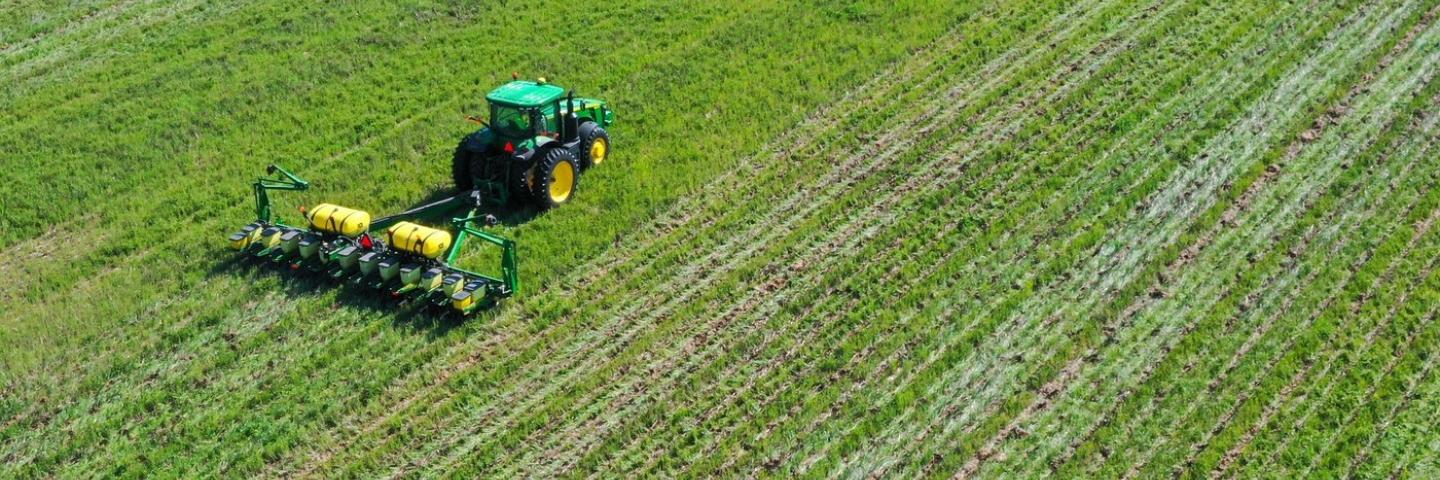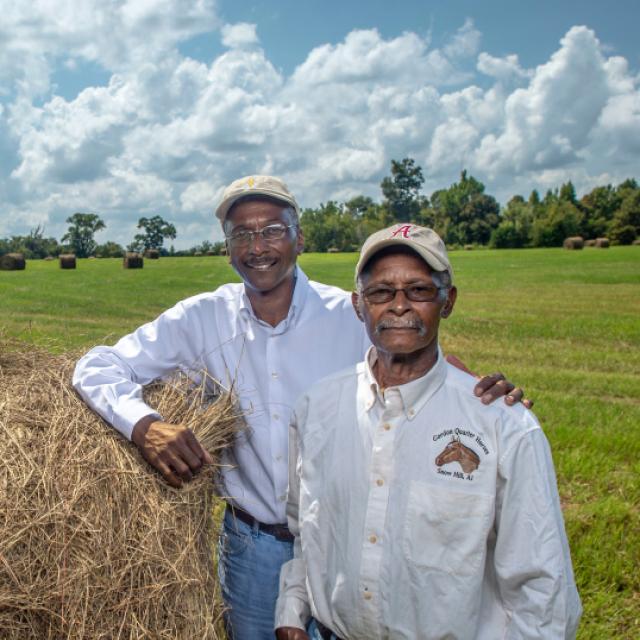
The Conservation Stewardship Program (CSP) helps you build on your existing conservation efforts while strengthening your operation.
CSP in Utah
Good land stewardship not only conserves the natural resources on your farm, ranch or forest, it also provides multiple benefits to local communities, including better water and air quality, as well as food and fiber. Through CSP, we work with you to build your business while implementing conservation practices that will help ensure the sustainability of your entire operation.
Eligible lands include cropland, pasture lands, rangeland, farmsteads, non-industrial private forest lands, and agricultural land under the jurisdiction of an Indian tribe. The program also provides equitable access to all producers, regardless of operation size, crops produced, or geographic location.
Whether you are looking to improve grazing conditions, increase crop resiliency, or develop wildlife habitat, we can custom design a CSP plan to help you meet those goals.
FY2026 Deadlines for EQIP, CSP, and AMA Initiative fund pools are:
- January 15, 2026: Batch 1 application deadline.
- April 3, 2026: Batch 2 application deadline (EQIP and CSP).
- July 24, 2026: Batch 3 application deadline (EQIP and CSP).
Conservation Activities
Conservation activities include conservation practices, enhancements, and bundles. Conservation practices must meet the criteria in the conservation practice standards and specifications available in the Field Office Technical Guide (FOTG):
- Enhancements are a conservation activity used to treat natural resource concerns and improve producer conservation performance.
- CSP enhancements.
Eligibility
Applicant Eligibility – Applicants may include individuals, legal entities, or joint operations. All CSP applications must meet the following eligibility requirements for CSP "Classic":
- Be the operator, owner, or other tenant of an agricultural operation in the Farm Service Agency (FSA) farm records management system. Note: Producers must establish or update records with FSA before NRCS will consider them eligible.
- Have effective control of the land (as defined in the CSP regulation at 7CFR Part 1470) and include all eligible land in their entire operation in their contract.
- Comply with highly erodible land and wetland conservation provisions and comply with Adjusted Gross Income provisions.
- Comply with provisions for protecting the interests of tenants and sharecroppers, including the provisions for sharing payments on a fair and equitable basis.
Land Eligibility – CSP is available to all producers, regardless of operation size or type of crops produced. Eligible lands include private agricultural lands (crop, pasture, and rangeland), nonindustrial private forest land (NIPF), associated agricultural land, and farmstead.
- Public land associated with the land uses described above is eligible, if under the effective control of the applicant, and if a working component of the producer’s agricultural or NIPF operation.
- Producers must have effective control of the land for the term of the proposed contract (five years for CSP).
- Contracts must include all eligible land associated with the applicants agricultural or NIPF operation.
Stewardship Threshold Eligibility – NRCS will use the Conservation Assessment and Ranking Tool (CART) to determine whether or not the applicant is addressing resource concerns in order to meet the stewardship eligibility requirement. An applicant's conservation activities must meet or exceed the stewardship threshold on all land uses for both of the following:
CSP – "Classic"
- At least two resource concern categories at the time of contract offer on all land uses included in the operation.
- At least one additional resource concern category by the end of the conservation stewardship contract on at least one land use.
Additional restrictions and program requirements may apply.
CSP Payments
Participating in the program represents a genuine commitment to conservation. Contracts are for five years.
- Utah CSP Payment Schedules FY 2026 coming soon.
How To Get Started
The first step in the process, is to notify NRCS of your interest in CSP. Then a conservation planner will schedule a visit to your property. During that visit, they will walk the land with you to discuss and review any resource concerns. Following the site visit, the conservation planner will develop a conservation plan that includes a variety of conservation practices, activities and enhancements to improve the level of conservation benefit and to address the resource concerns.
If you're ready to take your conservation efforts to the next level we are here to help. NRCS accepts CSP applications on a continuous basis. Applicants must submit Form NRCS‐CPA‐1200, “Conservation Program Application,” and a map delineating the entire agricultural or NIPF operation -- NRCS-CPA-1200 Conservation Program Contract.
Application Ranking
Eligible applications that meet the stewardship threshold eligibility requirements will be ranked using the Conservation, Assessment, and Ranking Tool (CART). NRCS ranks CSP applications based on the following factors:
- Level of conservation treatment on all targeted resource concerns at the time of application.
- Degree to which proposed conservation activities effectively increase conservation performance.
- Number of, and extent to which, targeted and non-targeted resource concerns will be treated by the end of the contract.
- Utah Ranking Criteria and payment Schedules for FY 2026 coming soon.
Benefits to Participants:
Subject to the availability of funds, participants will receive one payment per fiscal year of the contract, as soon as practicable after October 1, which includes:
- An annual payment for maintaining and managing existing conservation activities.
- Payments for installing and adopting additional conservation activities.
- Supplemental payments on cropland where a resource conserving crop rotation has been adopted or improved.
James Huggard
james.huggard@usda.gov
CSP Program Manager
USDA-Natural Resources Conservation Service
1090 N. Des Bee Dove Road
Castle Dale, UT 84513
(435) 381-2300 ext.109
Ready to get started?
Contact your local service center to start your application.
How to Get Assistance
Do you farm or ranch and want to make improvements to the land that you own or lease?
Natural Resources Conservation Service offers technical and financial assistance to help farmers, ranchers and forest landowners.

To get started with NRCS, we recommend you stop by your local NRCS field office. We’ll discuss your vision for your land.
NRCS provides landowners with free technical assistance, or advice, for their land. Common technical assistance includes: resource assessment, practice design and resource monitoring. Your conservation planner will help you determine if financial assistance is right for you.
We’ll walk you through the application process. To get started on applying for financial assistance, we’ll work with you:
- To fill out an AD 1026, which ensures a conservation plan is in place before lands with highly erodible soils are farmed. It also ensures that identified wetland areas are protected.
- To meet other eligibility certifications.
Once complete, we’ll work with you on the application, or CPA 1200.
Applications for most programs are accepted on a continuous basis, but they’re considered for funding in different ranking periods. Be sure to ask your local NRCS district conservationist about the deadline for the ranking period to ensure you turn in your application in time.
As part of the application process, we’ll check to see if you are eligible. To do this, you’ll need to bring:
- An official tax ID (Social Security number or an employer ID)
- A property deed or lease agreement to show you have control of the property; and
- A farm number.
If you don’t have a farm number, you can get one from USDA’s Farm Service Agency. Typically, the local FSA office is located in the same building as the local NRCS office. You only need a farm number if you’re interested in financial assistance.
NRCS will take a look at the applications and rank them according to local resource concerns, the amount of conservation benefits the work will provide and the needs of applicants. View Application Ranking Dates by State.
If you’re selected, you can choose whether to sign the contract for the work to be done.
Once you sign the contract, you’ll be provided standards and specifications for completing the practice or practices, and then you will have a specified amount of time to implement. Once the work is implemented and inspected, you’ll be paid the rate of compensation for the work if it meets NRCS standards and specifications.

